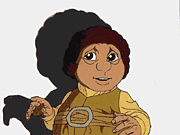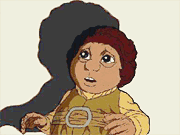I started collecting animation celluloid sometime around 1998, but I don’t remember how I got started. Cels are the hand-painted “frames” that were actually used to animate what we see on the television. Therefore, they are much like original stage props from a film set and can have much sentimental value on top of market worth depending on popularity of the animation and such. But later on, studios moved to computer-generated animation to save both production costs and time, and cels are no longer created. Vintage Disney cels can easily fetch five digits USD.
Instead, studios now digitally paint frames from hand-drawn paper and pencil sketches, called genga and douga in Japanese terminology (referring to different stages of production). Cel collectors like myself often continued looking for cels from old series while shifting our attention to the new “props” of the newer series.
I am not actively selling pieces from my collection, but you may still inquire.
The Hobbit
 Here’s an example (or two) of an animation celluloid—the pride of my collection, so to speak. But first, let’s talk a little bit about history. The Hobbit animated film was released in 1977 by the studios Rankin/Bass and Topcraft. Rankin/Bass is rather famous for other works as well, such as The Last Unicorn and several Christmas holiday specials like Frosty the Snowman.
Here’s an example (or two) of an animation celluloid—the pride of my collection, so to speak. But first, let’s talk a little bit about history. The Hobbit animated film was released in 1977 by the studios Rankin/Bass and Topcraft. Rankin/Bass is rather famous for other works as well, such as The Last Unicorn and several Christmas holiday specials like Frosty the Snowman.
 Now, for a long time in the history of animation, the traditional production materials involved—from rough pencil sketch to painted celluloid—were considered detritus or mere by-products of the final art piece. That means they were almost always destroyed: trashed or, in the case of celluloid sheets, “dipped” to remove paint so the plastic could be reused. Another issue is that studios consider these production materials to be strictly their intellectual property, so they could not be freely given away or traded (I think this mindset happened later, though I have no proof). The Hobbit production most likely underwent such destruction procedures, which is why cels from this animation (and other Rankin/Bass 2D works) are exceptionally rare.
Now, for a long time in the history of animation, the traditional production materials involved—from rough pencil sketch to painted celluloid—were considered detritus or mere by-products of the final art piece. That means they were almost always destroyed: trashed or, in the case of celluloid sheets, “dipped” to remove paint so the plastic could be reused. Another issue is that studios consider these production materials to be strictly their intellectual property, so they could not be freely given away or traded (I think this mindset happened later, though I have no proof). The Hobbit production most likely underwent such destruction procedures, which is why cels from this animation (and other Rankin/Bass 2D works) are exceptionally rare.
Less known about the Hobbit production was the collaboration with Topcraft. This Japanese studio was the root of what was to become the famed Studio Ghibli; that is, several former members of Topcraft went on to create Studio Ghibli. The Hobbit thus has a particularly rich artistic parentage.
I had been looking for cels from The Hobbit for some years and happened to stumble upon them by chance. Recognition of value for this sort of thing requires, first and foremost, sentimental value. I watched the film as a child and was mesmerized by that magic animation, and even now after rewatching as an adult, I still appreciate the detailed drawn lines that are lacking in nearly all current forms of animation. Other elements of value follow the same lines as other types of artistic collections: popularity, fame, quality, etc.
In the end, I managed to get torso-shot quality cels of Bilbo from the scene where he’s dealing with the dwarves messing up his hobbit hole and being convinced by Gandalf to undertake an adventure. The cels were quite faded considering their age, but I can proudly say that I own a piece of this animation history and art.